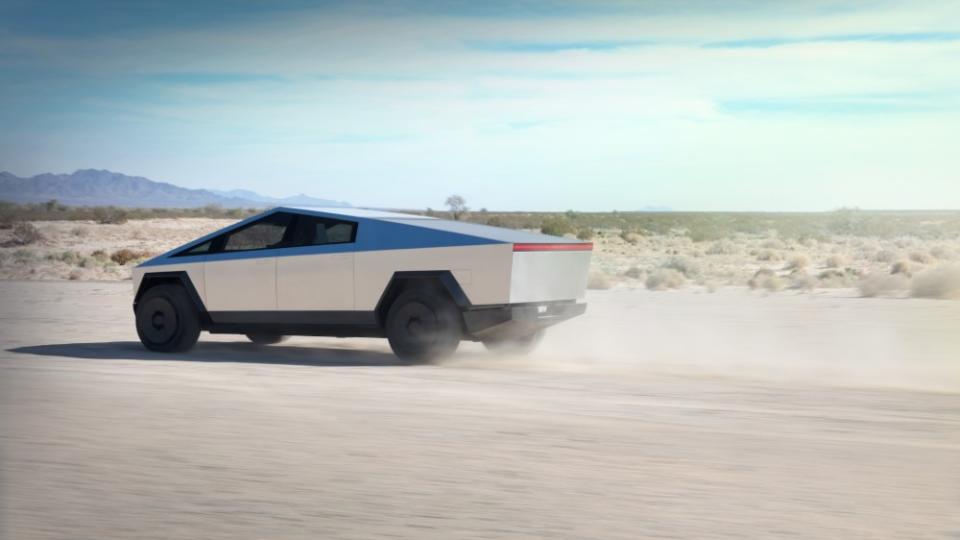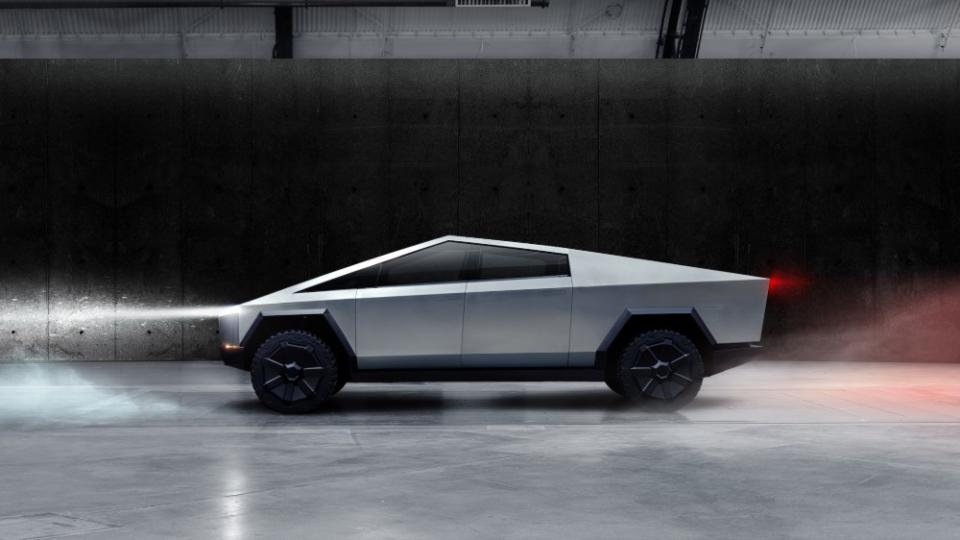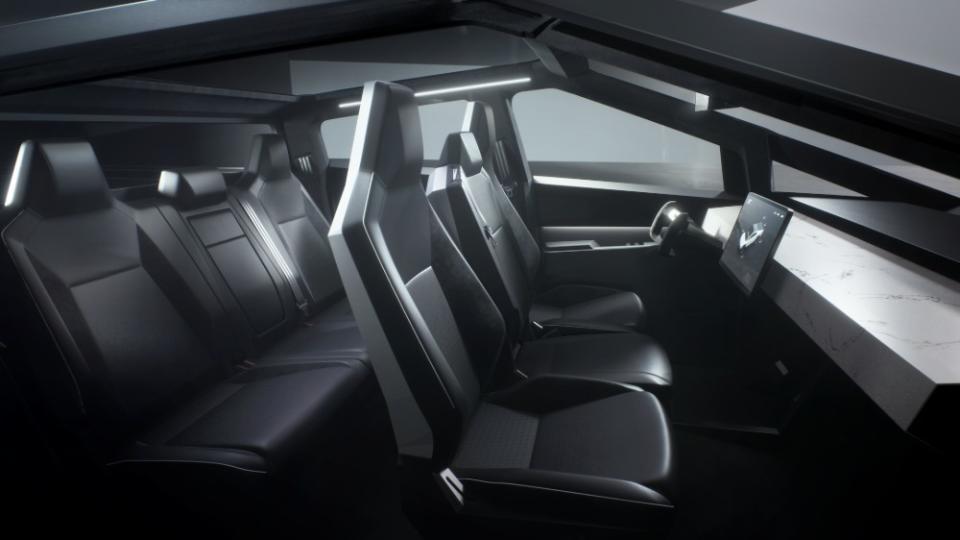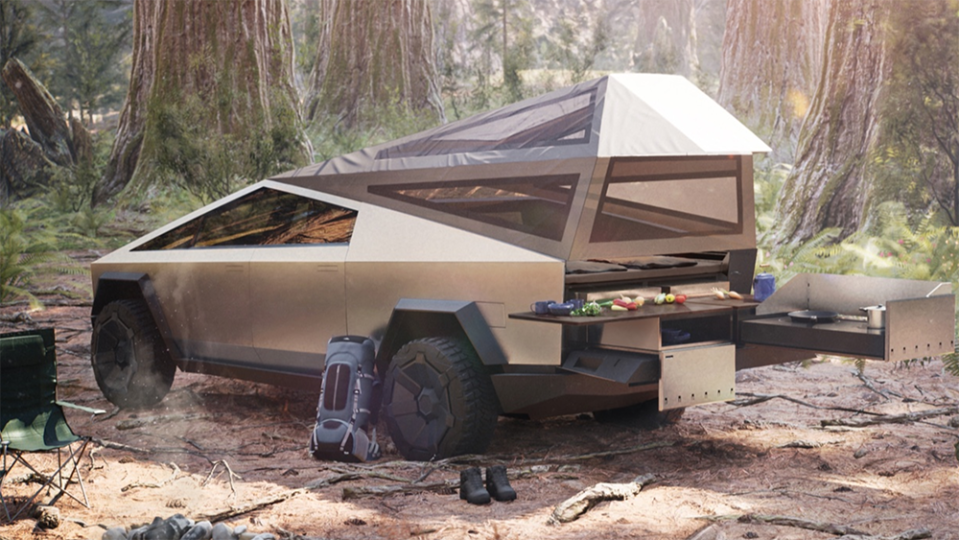Everything We Know About the Tesla Cybertruck

Overview
It’s hard to think of a vehicle that has received as much fanfare as the Tesla Cybertruck did upon its unveiling in the fall of 2019. Whether you’re an auto enthusiast, a tech obsessive or just an average Joe who has spent time online the last few years, chances are you’ve now heard about the EV giant’s first truck and you probably have an outsize opinion about it.
Why so much attention for a pickup truck? It could have something to do with the company’s CEO, Elon Musk, and his penchant for tweeting about “the coolest car [he’s] ever seen.” The tech titan promised a futuristic vehicle that would look like something out of the sci-fi classic Blade Runner. And while that may have been a bit of a stretch, there’s no denying that the Cybertruck looks like nothing on the road, gas- or battery-powered.
More from Robb Report
Tesla's Cybertruck Could Be a Serious Danger to Pedestrians and Cyclists, Experts Say
Tesla Cybertruck Debuts With Less Range, Towing Capacity, and a Higher Price Than Promised
BMW Wants to Make an Electric Performance Car But It Will Never Be Called iM3
That’s because the all-electric pickup seems to throw almost everything we thought we knew about automotive design out the window. There are no rounded corners or flowing, aerodynamic lines, just sharp edges and dramatic angles. The vehicle’s exterior has more in common with the polygonal vehicles in a primitive video game than it does any other cars currently on the market. But because this is a Tesla, the car promises some mighty impressive performance numbers, including 300-plus miles of range and the ability to tow up to 11,000 pounds.
Of course, in what has become a signature practice with the company, the electric truck took its sweet time getting here. Originally, Musk said the vehicle would go into production in 2021, but that date was soon pushed back a year because of supply chain issues caused by the Covid-19 pandemic. In January of 2023, Musk confirmed reports that Tesla would finally start building the Cybertruck this year and, in July, the first finished example rolled off the line at Gigafactory Texas. Then, at the end of November, the company delivered the first production examples of the EV to a group of very excited customers. Don’t expect to see it on the road anytime soon, though. Mass production won’t begin until 2024. In the meantime, here’s everything we know about one of the most hotly anticipated vehicles in recent memory.

Cybertruck’s Engine, Specs and Performance
While the Cybertruck’s outlandish exterior may be what earned it so much attention in 2019, the most radical aspect of the vehicle may be its performance. Never one to undersell, especially a vehicle he had spent so much time building up, Musk basically promised that the truck would represent an electric revolution of sorts.
When it eventually goes on sale, the Cybertruck will be available in three different variants. The entry-level pickup, which won’t launch until 2025, features one motor and a rear-wheel-drive system, while the two- and three-motor models, the latter of which is called the “Cyberbeast,” will both have all-wheel drive. As you may have guessed, the more motors your Cybertruck has, the better its performance, with the tri-motor version able to zoom from 0 to 60 mph in less than 3 seconds, which is basically unheard for a production truck. So far, Tesla has only provided specs for the two more powerful models, saying that the dual-motor powertrain will produce 600 hp and 7,435 ft lbs of torque, while the tri-motor setup will pump out 845 horses and 10,296 ft lbs of twist. The two models have ranges of 340 and 320 miles, respectively, which are good, but nowhere near the 500 miles Musk promised in 2019 (the rear-wheel-drive pickup can only drive 250 miles on a charge).
The truck also promises the kind of towing capacity normally associated with the most powerful gas-powered trucks on the road. Tesla claims the dual- and tri-motor models will be able to tow 11,000 pounds, which is as much as the Rivian R1T and more than the Ford F-150 Lightnting, but less than the 14,000 pounds that was originally quoted. The pair’s claimed 2,500-pound payload capacity is also 1,000 pounds less than it was supposed to be. Still, both figures are more than solid.

The Sci-Fi Exterior
Any conversation about the Cybertruck will likely start with its exterior—and rightly so. The pickup looks like nothing on the road today, or at any time in the past for that matter. And it’s hard to imagine that changing.
Almost from the moment it was revealed, the Cybertruck became a meme. The angular design is nothing if not bold. While other automakers obsess about smooth curves and flowing aerodynamic lines, the pickup is all sharp angles and flat planes. And that doesn’t just apply to its general body shape, but elements like its striking strip-like LED headlights, geometric windows and chunky wheel fenders. In fact, the designers seem to have been so dedicated to its geometric shape that they decided to do away with side-view mirrors entirely (though they’ll be included on the eventual production model).
The vehicle’s out-there design does raise some questions, though. One reason why cars and trucks embrace shared design elements is that they help the car withstand the rigors of daily use and potential collisions. But this isn’t the case with the Cybertruck. For example, the vehicle lacks a “crumple zone,” the area meant to absorb the force of a crash. Presumably, to offset this, the EV will feature an “impenetrable” structural skin of Ultra-Hard 30X Cold-Rolled stainless steel. Let’s hope it’s tougher than Tesla’s Armor Glass. The supposedly unbreakable material embarrassingly shattered not once but twice during the vehicle’s unveiling.
The Cybertruck’s bold design may have some unforeseen benefits, as well. Shortly after the first production example rolled off the line, the company revealed that the EV, which has four doors like other double-cab trucks, will measure less than 19 feet and have a bed over six feet long. That means that despite being shorter than its chief rival, the Ford F-150 Lightning, it has a longer bed. Its shorter length also means that it can fit into a standard garage, which was a genuine concern after its unveiling.
Is the Cybertruck a thing of beauty? No. Are there some questions about whether or not its design is even feasible? Yes. But Tesla and Musk deserve credit for designing a pickup that few can look away from. Not only does the EV look markedly different from other trucks on the market, it completely breaks from the design language of the rest of the brand’s roster. Love it or hate it, you have to admit that the road will be a more interesting place with it in action.

The Spare Interior
The Cybertruck’s interior is nearly as unique as its body. The exterior’s design language has been carried over, meaning there are lots of sharp angles, especially in the dashboard area, which looks like a flat ledge with a steering wheel and massive 17-inch touchscreen protruding out of it. It’s all a bit spartan, as are the seats. There’s some padding visible, but they don’t exactly scream comfort.
Yet the interior does look roomy. The marque claims that the Cybertruck, regardless of the version, can comfortably sit six adults and has 100 cubic feet of exterior storage. This will make sense to anyone who’s seen the Cybertruck up close; it’s 6.4-foot truck bed, or cargo bay as some are calling it, looks genuinely massive. But exterior storage isn’t just about the bed; the vehicle also offers lockable storage, including a vault, trunk and sailing pillars.
Add-Ons and Accessories Galore
Musk has promised that the Cybertruck will be so much more than a normal pickup. In 2019, the CEO said that the vehicle would be available with some “sick attachments.” We’ve yet to see the stainless-steel, Airstream-like trailer that was teased a couple years back, but a Basecamp tent, range extender battery pack and tailgate ramp were all teased during the delivery event.
And those are just the official, first-party accessories. Other companies are already trying to get in on the action. The years since the truck’s public debut have seen a slew of Cybertruck-inspired projects pop up around the globe. Perhaps most notable among these is a huge compound called the Cyberhouse that was very clearly inspired by the vehicle—and offers a garage that can actually house the pickup.

The Cybertruck’s Price: Is It Worth It?
One of the biggest questions surrounding the Cybertruck before the delivery event—and which could be most vital to its future—is how much it would cost. When it was first announced, Musk teased a paradigm-shifting vehicle that would be surprisingly accessible. Despite its cutting-edge features and beefy performance, the company said the single-motor model would start at an affordable $39,900, and the dual-motor and tri-motor editions at $49,900 and $69,900. Those numbers, it’s now clear, were rather optimistic. Following the delivery event, the Cybertruck’s reservation page lists a $60,990 starting price for the rear-wheel-drive model, $79,990 for the all-wheel-drive model, and $99,990 for the Cyberbeast.
Those prices aren’t outlandish, especially as far as high-powered EVs go, but they are significantly more than initially promised. Some 1.8 million pre-orders have been placed for the Cybertruck since its debut—though they only required a refundable $100 deposit—and it remains to be seen how many people will move forward now that they know what the EV can do and what it will actually cost. Of course, if even half do decide to purchase the pickup, it will qualify as an undeniable hit.
More stories about the Cybertruck from Robb Report:
Elon Musk Says Tesla ‘Dug Our Own Grave’ With the Cybertruck
Tesla’s Cybertruck Won’t Be Able to Tow Anywhere Near the 14,000 Pounds It Promised
Tesla Cybertruck Debuts With Less Range, Towing Capacity, and a Higher Price Than Promised
Best of Robb Report
Sign up for Robb Report's Newsletter. For the latest news, follow us on Facebook, Twitter, and Instagram.

